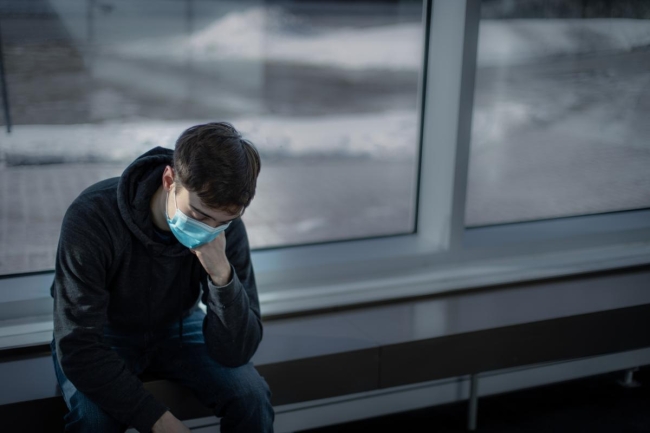You have /5 articles left.
Sign up for a free account or log in.

lightspeedshutter/iStock/Getty Images Plus
Many college and university leaders are preparing for the return of students to campuses this fall by making a renewed push to provide increased mental health services to help those still processing the events of the past year navigate the transition back to in-person learning. The administrators also want to help students manage stressors related to remaining uncertainties about COVID-19 and the path of the pandemic.
A number of studies have shown young adults struggling with stress, anxiety, depression, suicidal ideation and substance abuse during the pandemic. A report from the Centers for Disease Control and Prevention released in March found that mental health problems rose for Americans from August 2020 to February 2021, with some of the largest increases among those ages 18 to 29. About 57 percent of that age group reported experiencing symptoms of anxiety and depression within the last seven days, up from 49 percent at the beginning of the survey period.
Kevin Banks, vice president of student affairs at Morgan State University, said he expects a fresh wave of mental health challenges among students this fall, including anxieties about disparate mask use and vaccinations and the process of reintegrating into a campus social life. Morgan State will be fully reopening this fall for the first time since the start of the pandemic.
“Coming back after being behind the boxes, as I call them, those little squares -- Zoom calls … Google Meets, it’s really going to be a different space for students,” he said.
The historically Black university in Baltimore intends to hire two new counselors as soon as possible, one to work in the evenings and another with expertise working with student athletes, he said.
“The competition for hiring counselors is unbelievable,” he said. “We’re competing with 14 or 15 other colleges and universities in the area. Everyone’s trying to upstaff their counseling center.”
University administrators also put together a 43-person “resocialization and re-acculturation” committee to help the university prepare for the fall semester. One of the goals of the committee is to figure out how to go about collectively “taking some time to acknowledge what we’ve gone through over this past year” while also celebrating the return to campus for students and employees, Banks said.
John Dunkle, senior clinical director for higher education at the JED Foundation, which focuses on young adult mental health, has seen “numerous examples” of colleges investing in mental health resources ahead of the fall. He noted that the combination of pandemic-related financial strains on students and concerns about their physical and mental health, and the continuing tensions on and off campuses nationally over racial injustices highlighted by the killing of George Floyd last summer have created a “Gordian knot” of mental health challenges for students. Paired with the unpredictability of the pandemic and widespread grief over the hundreds of thousands of lives lost, Dunkle said, college leaders have their work cut out for them.
“They need to be prepared to help provide space for their communities to heal from trauma, from death, grief and loss, and vicarious traumatization,” Dunkle said. Students of color and other student groups disproportionately affected by COVID-related sickness and death and job loss will need targeted supports.
State University of New York chancellor Jim Malatras announced July 23 that the system would direct its 64 campuses to invest 5 percent of their respective COVID-19 relief funds in mental health supports for students, a total of $24 million across the system. The funding would supplement the $35 million campuses already invested in mental health programs for the 2021-22 academic year. The new funding will go toward training residential staff to identify students struggling with mental health problems and refer them to appropriate supports and to expanding SUNY’s counseling services, peer-to-peer hotlines and crisis text line.
“Our students are dealing with a once in a lifetime health crisis -- first from the fear of the unknown and being away from family and friends, and now as we readjust to being in-person again -- and coupled with the normal pressures of college, it is affecting their wellbeing at a higher rate,” Malatras said in a press release. “We can’t expect students to thrive if we can’t be there for them in their time of need. Our students are demanding additional services and we hear them.”
Eddie Howard, vice president of student affairs at Northern Kentucky University, said he believes investments in student mental health may also help campuses recover from enrollment losses. Higher education institutions across the country continued to experience enrollment declines this past spring, dropping by 3.5 percent during the spring 2021 semester compared to the spring 2020 semester, according to National Student Clearinghouse Research Center data.
Northern Kentucky is using COVID-19 federal relief funds and state appropriations to start a few mental health initiatives, including a peer training program to teach about 40 students per semester to identify warning signs of mental health challenges among classmates and refer them to resources on campus. The goal is to create an “army” of students equipped to help each other, Howard said. The university will also continue to waive the $15 counseling session fees for uninsured students on campus this fall, as it did during the past academic year, and plans to increase the number of counselors available to students.
“I think if we as institutions of higher education can show that we understand that some students might come to us with some mental health concerns, which in some cases haven’t even been diagnosed, if we can tell them that we have support services in place … I think that would encourage more students to want to come to campus, especially if they’re in a situation during the pandemic where they’ve been isolated or there’s not a lot of interaction” with peers, Howard said.
Students with mental health diagnoses were already at risk of dropping out before the pandemic and are going to need help readjusting to campus life, said Anna Guimaraes, program manager for College Re-Entry, a program designed to help students re-enroll after leaving college because of mental illness. The program, which is a branch of a New York-based mental health organization called Fountain House, usually offers three, in-person, 14-week sessions per year for cohorts of 10 students, with classes on academic skills building and mental wellness and one-on-one coaching to devise a re-enrollment action plan.
Only 18 students participated last year, in part because students usually join the program when they feel “optimistic and ready to get back on the horse and return to college -- and that wasn’t the experience for a lot of people through the pandemic,” Guimaraes said.
The program will offer six sessions, three in person and three online, during the 2021-22 academic year, because Guimaraes is expecting an “influx of re-entry” among students who dropped out because of mental illness.
“We anticipate there will be a new optimism, and with that optimism, there’s probably going to be a lot of anxiety,” she said.
Hannah, a student at the University of Maryland Global Campus, who goes by the pronoun “they” and requested to be identified by first name only, participated in the program during the pandemic last fall, two years after dropping out of college. Hannah had been wrestling with a thought and processing disorder, which made it difficult to focus on class material and made their speech sound confused and jumbled, which contributed to them feeling depressed.
Hannah said they were struggling to pay for college out of pocket at the time, and trying to communicate thoughts and ideas that sound like “word soup” felt like yet another barrier.
“My stress level was already very high,” they said. “Just to not be able to communicate what was going on was extremely difficult.”
Before receiving a diagnosis, “I ended up just having to go to a nurse and saying, ‘I don’t feel well, and I don’t know how to fix it,’” they added.
Hannah returned to college this spring and plans to continue this fall. They recommended universities hire more mental health professionals ahead of the upcoming semester as a first step to help other students returning after struggling with mental health challenges.
O’Neil Mahoney, who participated in the College Re-Entry program in 2018, plans to transfer from Borough of Manhattan Community College to Columbia University this coming fall. He believes universities should offer students with mental health challenges “dual support” -- help with tasks such as writing assignments and self-care techniques.
When Mahoney first started college, he felt overwhelmed as a Black student from a low-income background at a predominantly white institution, he said, and those stresses were exacerbated by his generalized anxiety and depression, which ultimately caused him to drop out.
He said the re-entry program gave him “this community of people who were supportive, who wanted you to achieve and helped you with problem solving,” and he believes students who have struggled with mental health and are re-entering college would benefit from a similar approach.
Dunkle, the clinical director at the JED Foundation, noted that the uncertainty of the pandemic, and its accompanying stresses for students, are hardly over. The uptick in coronavirus cases caused by the Delta variant has already prompted colleges to shift some of their COVID-19 policies.
“We’re still not out of the woods,” he said. “There’s a lot of ambiguity about what’s going to happen in the fall still. Campuses need to be planning now, if they haven’t already, about the impact of everything that’s happened over the last year and a half. And if we have to slide back to masks and isolation and returning home, that’s going to have a huge impact on our communities, whether it’s students, faculty or staff.”





